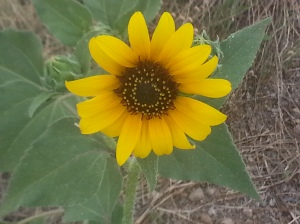Sunflowers! The quintessential western wildflower that symbolizes the sun.
These are wild sunflowers, the parent of our domesticated sunflowers. The biggest difference between the two is that the wild sunflower has multiple heads and the domesticated has a single stalk and single flower that is larger with larger seeds.
The wild sunflower has the advantage if you want to eat the flower buds, the size is perfect if you pick them and steam them like globe artichokes.
Sunflower seeds are edible and make a high quality cooking oil.
Sunflowers are great phytoremediators to remove toxins such as lead, arsenic, and uranium from soil. They were used at Chernobl to remove cesium-137 and at Fukushima to remove strontium-90. On my 14 acres in Texas to remove arsenic.
If in healthy soil, Sunflowers are edible, flower buds, seeds, oil, stems. I read that germinated seeds are blended with water to ferment into a seed yogurt. I haven’t tried that but added it to my list of things to try.
A tea from the leaves is astringent, diuretic, expectorant, and fever reducing. Sunflower leaf tea has been used for malaria and lung ailments. Collect as the plant begins to bloom and dry for later use.
Fiber from Sunflower stems are used to make paper.
There are many uses for Sunflowers, but I grew Mammoth Sunflowers in Texas against my unshaded west wall to lower my air conditioning bills and improve my home comfort. Instant shade is wonderful while waiting for a young tree to grow into the job. I had eastern shade or would have done the same for Texas morning sun.
In forest fire areas like where I live, Sunflowers can provide temporary shade to your walls without being a fire hazard. I grew wild sunflowers on the southwest side of my house last year, and it was wet enough for them to grow 8 feet tall.
Another thing I used Sunflowers for was to add plant diversity to my 14 acres. A 4 pound sack of black Sunflower oil birdseed, sprinkled lightly across my acreage brought birds and birds dropped seeds of their own to sprout and grow. It went from a dozen species to over 300.
Spread the bigger varieties of Sunflowers out and they make perfect living poles for indeterminate beans. No storage issues, compost at the end of the year and they are not only edible, they are gorgeous.
One more thing about Sunflower seeds, they are high in Vitamin E, our primary antioxidant that supports cell membranes and brain cells, among other things.
I have grown wild and domestic Sunflowers and wild is a bit more drought tolerant in my very low rainfall area. I have too much shade for a large seed crop, but can grow plenty of flower buds to eat.
Sunflowers are wonderful for prairie locations and even shady food forests have sunny spots to grow a few.


I’ve only just learned about arsenic in soil. How long will it take the sunflowers to clear it?
Helen
1-3 years. I only used 4 pounds of seed on 14 acres. It took 3 years, just letting them multiply and removing the waste, burning it, and holding the ashes in barrels. I put in a pond… after3 years it green frogs moved on. I cried.
You mean, the green frogs didn’t like the ash?
I put the ash in barrels, it is fairly concentrated arsenic. The green frogs showed up when the arsenic in the soil and water drop low enough to not kill them. They are a canary in the coal mine for arsenic… they die at lower levels of arsenic than we do.
I get you now.